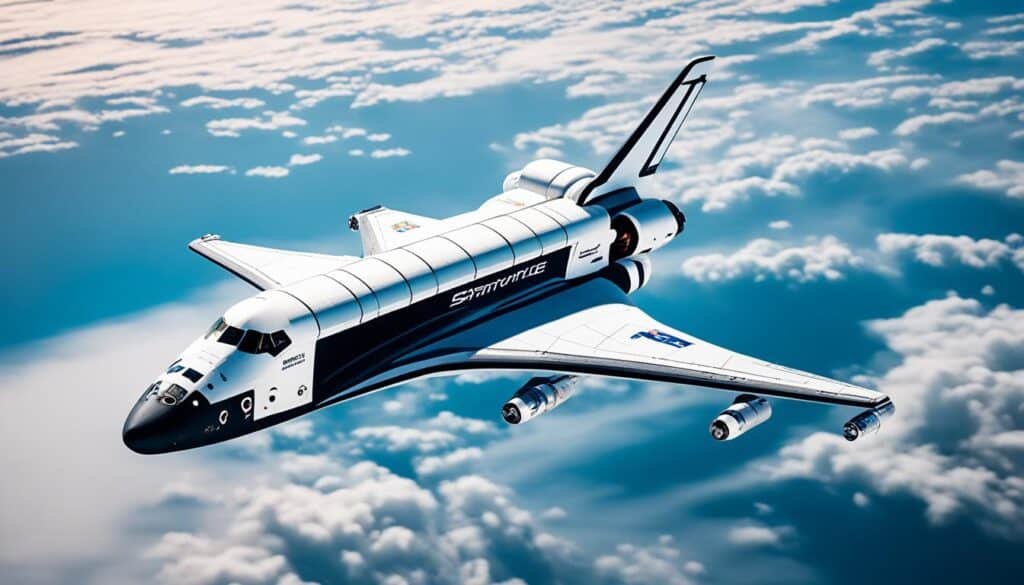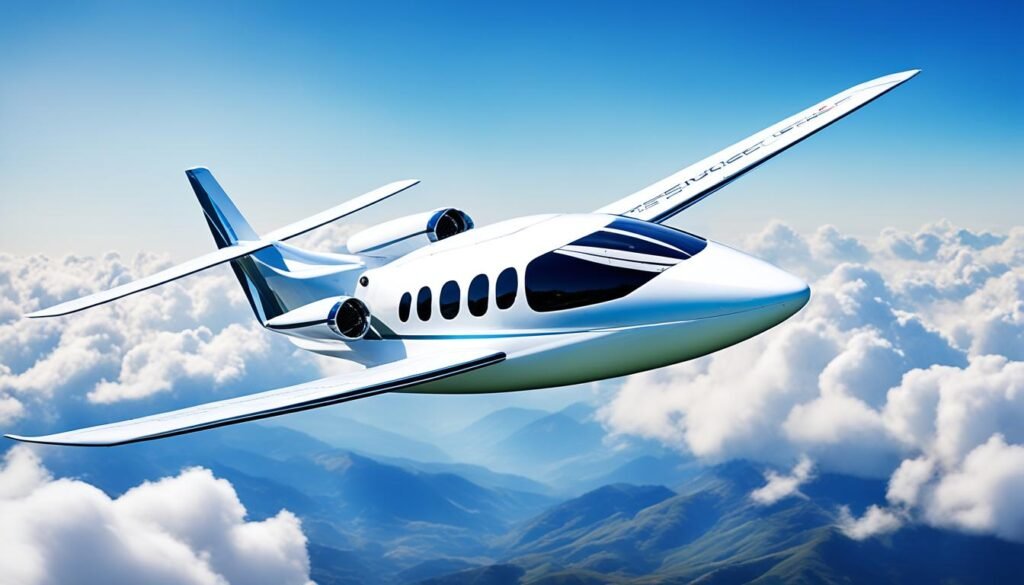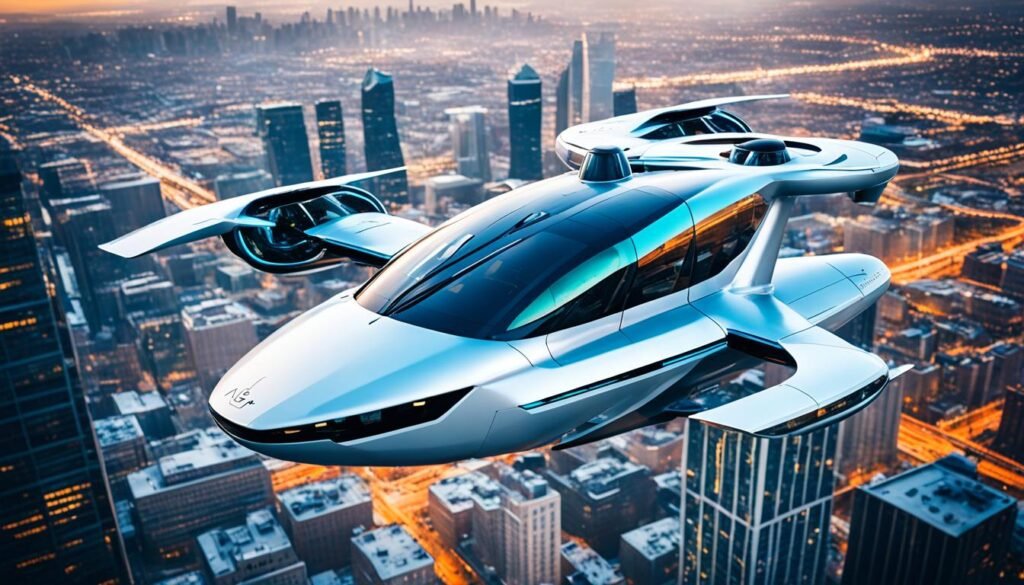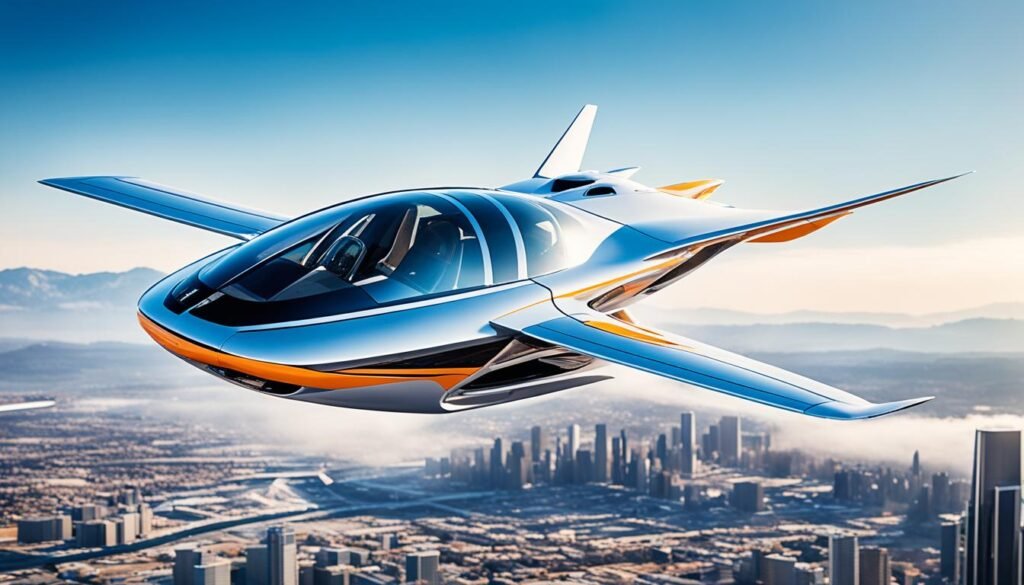The aerospace industry is going through big changes, with new innovations and advancements. These changes are shaping the future of flying and space travel. We’re seeing things like new materials, electric engines, and self-flying planes. This article looks at the newest trends and innovations in aerospace engineering.
Key Takeaways
- Aerospace engineering is seeing a lot of new tech, like lightweight materials, 3D-printed parts, and electric engines.
- Artificial intelligence and machine learning are being used more in aerospace, making things work better and more efficiently.
- New tech in fast flying and electric planes is making air travel quicker. Electric planes for city flying are also on the rise.
- The private space industry is helping make space travel more common for everyone.
- Self-flying planes and drones are becoming more common, offering new ways to move things and travel.
Introduction to Aerospace Engineering
Aerospace engineering is all about designing, building, and keeping aircraft and spacecraft running smoothly. It covers many areas like aerodynamics, structures, propulsion, avionics, and materials science.
Aerospace Engineering: Definition and Scope
Aerospace engineering uses science and engineering to tackle big challenges in aviation and space. Engineers work on everything from new aircraft to advanced spacecraft. They help shape the future of aerospace technology.
The Evolution of Aerospace Technology
The story of aerospace engineering is one of big leaps in technology. It started with the Wright brothers’ first flight and has grown to include reusable rockets and big space projects. The aerospace industry always looks for new ways to improve.
In the last hundred years, aerospace engineering has changed a lot. New discoveries have changed how we fly and explore space. The future looks bright, with lots of new things to come in aircraft design and spacecraft design.
Advancements in Aerospace Materials

The aerospace industry has made huge leaps in materials science. This has changed how aircraft and spacecraft are made. Key improvements have been in lightweight composites and aerospace alloys.
Lightweight Composites and Alloys
Materials like carbon fiber and advanced polymers are now big in aerospace. They are strong but don’t weigh much. This makes aircraft and spacecraft more fuel-efficient and long-lasting than old aerospace materials like aluminum aerospace engineering department bachelor’s degree department of aerospace engineering.
New aerospace alloys like titanium and nickel-based ones have also boosted performance. They make aerospace parts stronger and more reliable.
3D Printed Aerospace Components
3D printing aerospace and additive manufacturing aerospace have changed how we make aerospace parts. These methods make complex shapes fast and with less waste. They let us create parts that fit exactly what aircraft and spacecraft need.
| Material | Key Properties | Applications |
|---|---|---|
| Carbon Fiber Composites | High strength-to-weight ratio, corrosion resistance | Airframe structures, engine components, satellite panels |
| Titanium Alloys | Lightweight, high strength, corrosion resistance | Landing gear, engine parts, spacecraft structures |
| Nickel-based Superalloys | High-temperature strength, creep resistance | Turbine blades, rocket nozzles, spacecraft heat shields |
Advances in aerospace materials have made aircraft and spacecraft better in performance, efficiency, and safety. This opens doors for more innovation in aerospace.
Artificial Intelligence and Machine Learning in Aerospace

The aerospace industry is changing fast, thanks to AI and ML. These technologies are making big changes in aerospace engineering. They help make flying safer, predict maintenance needs, and improve how planes fly.
AI and ML automate many tasks, making things run smoother and faster. They keep an eye on aircraft systems in real-time. This helps aerospace companies fix problems early, making flying safer and cutting down on delays.
AI-powered data analytics is changing how aerospace companies make decisions. By using aerospace data analytics, they can find important information, predict when things need fixing, and plan better flight paths. This makes flying safer and saves money.
The use of AI aerospace and machine learning aerospace is making things more automated. These technologies do complex tasks on their own and help make better decisions. This is part of aerospace digitization, as the industry uses digital tools to stay ahead.
As the aerospace industry grows, using AI and ML will keep being important. It will help companies work better, keep flying safe, and stay competitive in aerospace engineering.
“AI and machine learning are the keys to unlocking the full potential of aerospace engineering in the 21st century.”
Aerospace Engineering: Electric Propulsion Systems

The future of aerospace engineering is changing fast with electric propulsion systems. These systems are key to making air travel more sustainable. The move to electric aircraft and electric aviation is vital for cutting down on air travel’s harm to the environment.
Benefits of Electric Aircraft Engines
Electric aircraft engines have many advantages over traditional ones. These advantages include:
- They are much quieter, making flights more comfortable for everyone nearby
- They produce fewer emissions, helping to lessen the aviation industry’s carbon footprint and supporting sustainable aerospace efforts
- They could be cheaper to run, with fewer parts and less maintenance needed
Advances in Battery Technology
The success of electric aircraft depends a lot on better aerospace battery technology. Batteries that hold more energy and charge faster are making electric planes better for short trips. As batteries get even better, electric planes will be able to fly farther and more often. This will help make flying with electric propulsion and electric aviation a reality for the future.
| Metric | Current Battery Technology | Projected Future Advancements |
|---|---|---|
| Energy Density | 200 Wh/kg | 300 Wh/kg |
| Charging Time | 1 hour | 30 minutes |
| Cycle Life | 1,000 cycles | 2,000 cycles |
“The transition to electric propulsion in aerospace is not just about reducing emissions, but also about improving the overall efficiency and performance of aircraft.”
Hypersonic and Supersonic Flight
The aerospace industry is moving fast in developing high-speed flight tech. This is changing the future of air travel. With hypersonic vehicles going over five times the speed of sound, and the return of supersonic planes, travel times will drop. This opens up new areas in aerospace.
The Future of High-Speed Air Travel
Hypersonic flight means going faster than five times the speed of sound. It’s drawing interest in military and scientific fields. These hypersonic flight vehicles could make long trips quick and allow for urgent missions. As we push the limits of supersonic flight and aerospace speed technology, fast air travel looks bright.
Supersonic Commercial Aircraft
There’s also a push to bring back supersonic commercial aircraft. These planes could make long flights shorter, making air travel faster and more convenient. With ongoing work on these supersonic aircraft, air travel is expected to get much quicker and smoother.
“The future of aviation is not just about getting from point A to point B faster, but about revolutionizing the entire air travel experience.”
Aerospace Engineering: Urban Air Mobility

The aerospace industry is changing fast with urban air mobility (UAM) technologies. Electric vertical take-off and landing (eVTOL) aircraft are leading this change. They could change how we move around cities.
eVTOL aircraft offer a new way to travel, avoiding ground traffic. These flying cars, or “air taxis,” use better batteries, fly on their own, and are made of lightweight materials. This makes city air travel efficient and green.
Electric Vertical Take-off and Landing (eVTOL) Aircraft
eVTOL aircraft are key to urban air mobility. They can take off and land vertically, so they don’t need big runways. This lets them fly in crowded cities.
eVTOLs have many advantages. They cut down on ground traffic, make trips faster, and emit fewer pollutants. As the aerospace urban transportation field grows, eVTOLs will be seen more in city skies.
Improvements in electric aircraft for cities and batteries have helped eVTOLs and flying cars become a reality. These changes are making urban air mobility a key part of our daily lives.
“The future of urban transportation will be defined by the rise of eVTOL aircraft, transforming the way we move through our cities.”
The Rise of Space Tourism
The aerospace industry is changing fast, with private companies leading the way in space tourism. Companies like SpaceX, Blue Origin, and Virgin Galactic are making it possible for people to go on suborbital flights. They will let civilians see the Earth from a new perspective.
Space tourism could make space travel available to more people. It’s not just for adventure lovers. It’s also a new way for the aerospace industry to make money and improve technology.
Private Companies Driving Space Tourism
Several companies are changing the game in space tourism. SpaceX, led by Elon Musk, is working on reusable rockets. This makes space travel cheaper and opens the door for more people to go to space.
Blue Origin, under Jeff Bezos, is also a big name in space tourism. They offer suborbital flights. Passengers can feel weightlessness and see the Earth’s curve.
Virgin Galactic, founded by Sir Richard Branson, is another key player. They’re creating new spacecraft for space tourism. Their spaceplane, the VSS Unity, takes customers to the edge of space and back.
“The rise of space tourism represents a paradigm shift in the way we view and interact with the cosmos. These private companies are not only making space travel more accessible but also igniting a new era of exploration and discovery.”
As space tourism grows, these companies will shape its future. They’re changing how we see and interact with space.
| Company | Founder | Spacecraft | Key Offerings |
|---|---|---|---|
| SpaceX | Elon Musk | Falcon 9, Crew Dragon | Reusable rocket technology, Suborbital flights |
| Blue Origin | Jeff Bezos | New Shepard | Suborbital flights, Weightlessness experience |
| Virgin Galactic | Sir Richard Branson | VSS Unity | Spaceplane flights, Edge of space experience |
Autonomous Aircraft and Aerospace Engineering
The future of air travel is getting a boost with autonomous aircraft. These planes can fly on their own, thanks to aerospace automation and AI-enabled flight tech. Aerospace engineers are leading the way with unmanned aerial vehicles (UAVs) that can fly without pilots.
Autonomous aircraft could make flying safer, more efficient, and cheaper. They can handle takeoff, landing, and flying without human help. This means fewer mistakes and more reliable flights.
“The integration of autonomous aircraft into the broader transportation ecosystem promises to reshape the future of air travel, making it more accessible, efficient, and sustainable.”
Researchers and engineers are exploring what autonomous flight can do. They’re using new sensors and smart algorithms to make flying planes smarter. These tech advances are changing how we see air travel.
Work on self-flying planes for regular flights and unmanned aerial vehicles for special tasks is moving fast. Aerospace engineering is leading this change. As things move forward, autonomous aircraft will make flying easier, cheaper, and greener.
Also Read: What Is The Future Of Software Engineering In The USA?
Conclusion
The aerospace industry is leading in innovation, always pushing new limits. It’s making big strides in aerospace materials and electric propulsion. Also, urban air mobility and space tourism are on the rise. This marks a big change for the industry.
For aerospace companies, staying ahead means investing in research and development. They need to tackle environmental issues, safety, and market trends. This will help them lead in the future.
By using the newest aerospace technology advancements and working with others, the industry can have a bright future. It aims for sustainable and efficient solutions. This will help meet the demand for air travel without harming the environment.
As the industry grows, aerospace experts must keep up and be flexible. They should use artificial intelligence and other new tech to move forward. With a focus on innovation, safety, and being green, the aerospace industry is set to change air travel and space exploration.
FAQs
Q: What is aerospace engineering?
A: Aerospace engineering is a field of engineering concerned with the development of aircraft and spacecraft. It involves the design, construction, and testing of aircraft and spacecraft as well as the study of aerodynamics, propulsion systems, and materials used in aviation and space exploration.
Q: What are the latest innovations in aerospace engineering?
A: Some of the latest innovations in aerospace engineering include advancements in hypersonic flight technology, reusable rockets, electric propulsion systems, and the development of autonomous aircraft.
Q: What types of programs are available for studying aerospace engineering?
A: Students can pursue undergraduate and graduate degree programs in aerospace engineering as well as specialized programs in aeronautical engineering, astronautical engineering, and systems engineering.
Q: What career opportunities are available for aerospace engineering graduates?
A: Aerospace engineering graduates can pursue careers in a variety of fields including aircraft and spacecraft design, research and development, systems engineering, and aviation technology. They may also work for government agencies such as NASA or in the private aerospace industry.
Q: What is the role of wind tunnels in aerospace engineering?
A: Wind tunnels are used in aerospace engineering to test the aerodynamic properties of aircraft and spacecraft models. They simulate the effects of airflow over a vehicle to help engineers optimize its design for efficiency and performance.
Q: How long does it take to complete a degree in aerospace engineering?
A: The duration of a degree program in aerospace engineering varies depending on the level of study. An undergraduate degree typically takes four years to complete, while a graduate degree can take an additional two to three years.
Q: Is aerospace engineering an accredited field of study?
A: Yes, aerospace engineering programs are typically accredited by the Accreditation Board for Engineering and Technology (ABET) or other engineering accreditation commissions to ensure that they meet quality standards and prepare students for careers in the field.
Source Links
- https://www.startus-insights.com/innovators-guide/aerospace-trends/
- https://astforgetech.com/7-emerging-aerospace-technology-trends-to-know-about-in-2023/
- https://thegeopolitics.com/the-future-of-aerospace-advancements-and-innovations/

